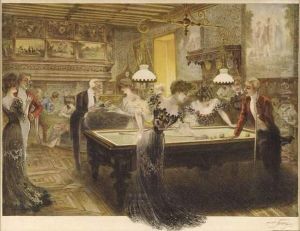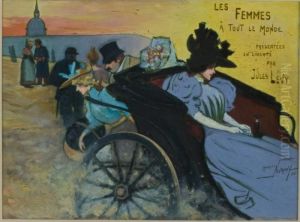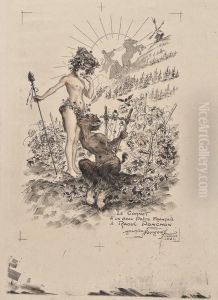Maurice Neumont Paintings
Maurice Neumont was a French painter, poster artist, and illustrator born on January 1, 1868, in Paris, France. His work was significant during the Belle Époque, a period characterized by optimism, regional peace, economic prosperity, and technological, scientific, and cultural innovations in the Western world. Neumont was trained at the École des Arts Décoratifs and the École des Beaux-Arts in Paris, where he honed his artistic skills and developed a distinct style that made him a notable figure in the art world of his time.
Neumont's work encapsulated the spirit of his era, often focusing on the vibrant Parisian life and the bustling urban scenery. He was particularly renowned for his poster art, a medium that was gaining immense popularity during the late 19th and early 20th centuries. His posters were not only advertisements but also works of art that captured the dynamic and elegant essence of Paris. He was a contemporary of other famous poster artists like Jules Chéret and Henri de Toulouse-Lautrec, who were also depicting the lively scenes of French nightlife and culture.
During World War I, Neumont's work took a patriotic turn. He contributed to the war effort by creating propaganda posters that were meant to boost the morale of the French public and encourage support for the troops. His posters from this period are characterized by their emotive content and powerful use of imagery to convey messages of solidarity and resilience.
Maurice Neumont was a versatile artist whose work extended beyond posters to include illustrations for books and journals, set designs for theaters, and paintings. His style was influenced by Impressionism, as well as by the graphic boldness of Art Nouveau. Despite the diversity of his work, he is perhaps best remembered for his contribution to the art of the poster, which had a lasting impact on the visual culture of his time.
Neumont's career was marked by recognition and success. He was awarded the Legion of Honour, which is the highest French order of merit for military and civil merits, in recognition of both his artistic talents and his patriotic contributions during the war. Maurice Neumont's legacy continued after his death on April 18, 1930, in Paris, as his works remained influential examples of early 20th-century graphic design and a testament to the rich cultural life of Paris during the Belle Époque.


